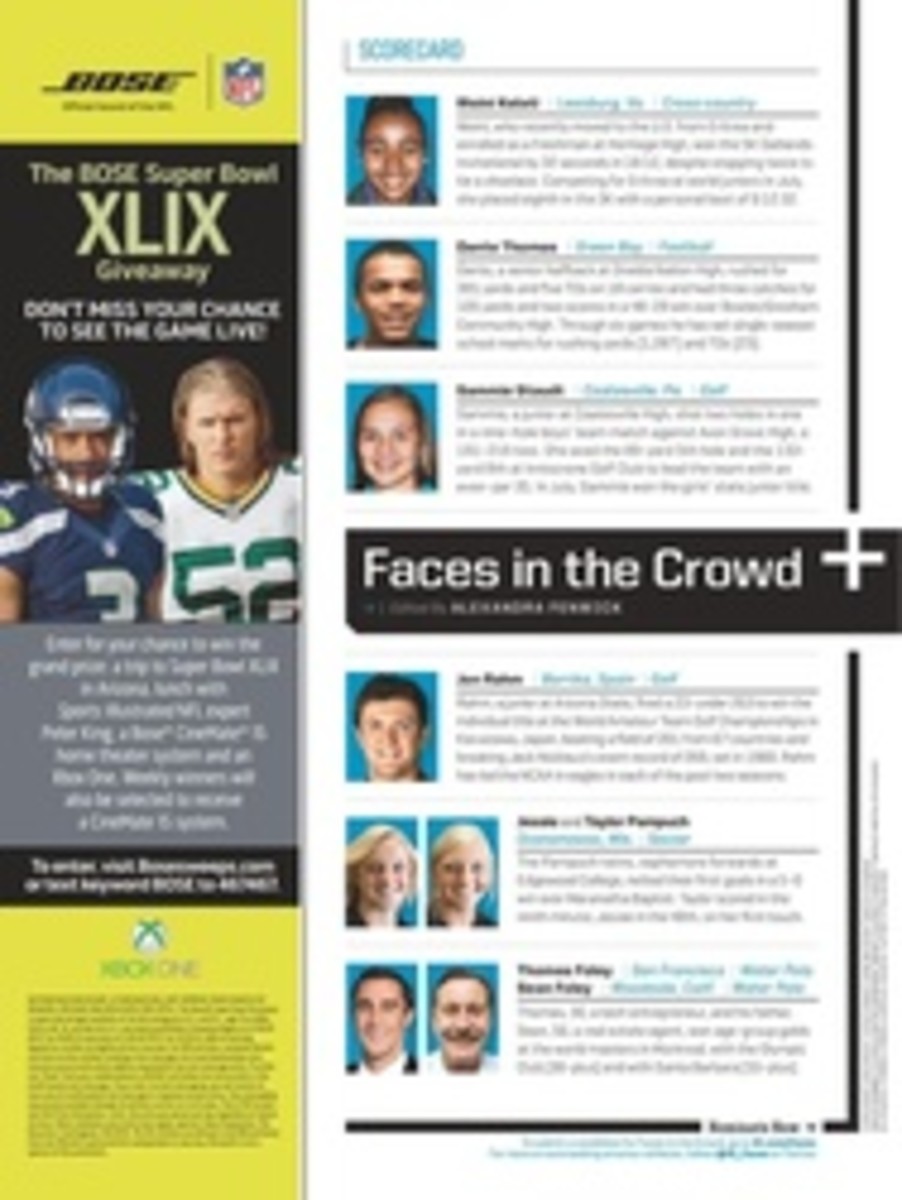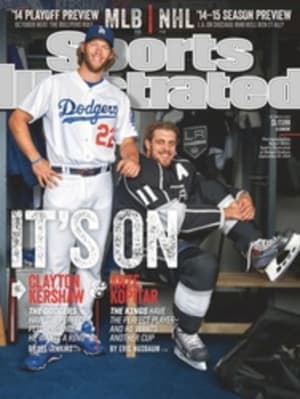
YOU WILL KNOW THEIR NAMES
THE STORY of the 2014 major league baseball season was best told on Sept. 22. It's nothing, really. Nothing, that is, as in runs scored. Six of the 12 games played that night ended in a shutout, a half-dozen more bagels added to a season full of them—353 to be exact, the most in 42 years.
If 1968 was the Year of the Pitcher, when aces such as Bob Gibson, Juan Marichal, Denny McLain and Luis Tiant were so dominant that baseball lowered the mound to give hitters a chance, this was the Year of the Pitchers, when an inexhaustible parade of hard-throwing specialists came marching out of bullpens with their 96-mph fastballs and tumbleweed beards to tamp what little offense there was into Dead Ball baseball.
It was harder to get a hit in the majors this season than any year since 1972. Runs per game sank to their lowest level in any full season since '76. The strikeout rate, hitting yet another record high, increased for a ninth straight year while the walk rate dipped to its lowest mark since—here we go again—1968. Sophisticated defensive shifts took away hits when batters did manage to get a ball in play.
How low can we go? Just wait for the postseason, which begins this week.
Runs historically become harder to find in October. Managers use only three or four starters instead of five; they are even more aggressive with their bullpen usage; and the teams with lousy pitching are playing golf. Last year, for instance, runs per game dropped 15% from the regular season to the postseason (8.34 to 7.11), batting average dropped 22 points (.253 to .231) and the at bats per home run rate increased 27% (from one every 35.6 ABs to one every 45.3).
So if we expect runs to become scarcer in the postseason, what does that mean for an October that follows the worst offensive season in more than 40 years? "It'll probably reflect the season we just went through," says Dodgers general manager Ned Colletti. "With all the extra scouting you do, all the extra preparation you put in, and combine that with focus being at its highest, you expect runs will be even harder to come by. Pitching, which is always important, becomes even more important."
Unlike 1968, when starters threw a complete game every 3.6 starts, today even the best starters get help. Complete games occurred once every 41.2 starts this season. This postseason will feature a few marquee starters, such as Dodgers lefthander Clayton Kershaw (21--3, 1.77 and a record-setting fourth straight ERA title), Dodgers righthander Zack Greinke (17--8, 2.71), Cardinals righthander Adam Wainwright (20--9, 2.38), Nationals righthander Stephen Strasburg (14--11, 3.14 and 242 strikeouts, tied for most in the NL) and Tigers righthander Max Scherzer (18--5, 3.15). But in general it's the depth of quality arms that is most impressive. "Some of the teams that clinched, you look at them and don't see dominant starting pitching," says Tigers president Dave Dombrowski. "But you see excellent staffs from top to bottom."
Says Cardinals GM John Mozeliak, "The thing about short series, every out becomes more magnified. That means leashes get shorter and bullpens need to be deep. When I reflect back on our 2011 run [to the championship] and our success in that postseason, it was predicated on our bullpen, which allowed us to stay in games and come back when we needed to."
An alarming number of elbow surgeries for young starting pitchers dominated the early-season headlines, as 2013 All-Stars Matt Harvey, Patrick Corbin, Matt Moore and Jose Fernandez were among the many pitchers who missed all or most of this season. But such is the inventory of hard throwers that baseball has been able to cover the spate of elbow injuries as if buying up power relievers by the palletful. Many of those pitchers aren't just throwing hard, but they also are combining movement with extreme velocity by cutting or sinking the ball. Fill your bullpen with enough of these specialists, use them several times per week for only a few batters at a time, and the last innings of games grind to a slow halt; while the hinges on the bullpen door get more action than the base paths.
This year batters hit .256 through the first six innings and only .241 in innings seven through nine. Baseball in the late innings today looks a lot like baseball in 1908, when batters hit .239—only with far more pitching changes and the convenience of electric lights at the ballpark. Reinforcing the trend, runs in innings seven through nine decreased every year from 2006 to '13.
THE SHUTDOWN of offense late in games was apparent in the 2013 postseason, when comebacks were rare. In the 38 games, only four times did a team trailing after six innings win a game. The Red Sox rode late-inning run prevention—and enough key hits late themselves to forge three of those four comebacks—to the World Series title. In 16 postseason games they held opponents to just 12 runs after the sixth inning.
"You really have to rethink your hitting philosophy," said Yankees hitting coach Kevin Long. "It used to be that you wanted to take pitches and get the starter's pitch count up so you could get into the other team's bullpen. Now if you do that, chances are you're going to see a better arm coming out of the bullpen, and it's one after the other. I mean, look at Andrew Miller [of Baltimore]. Wow. He's so nasty, do you want to see him? It seems every team now has two, three, four guys with nasty stuff they can go to."
Miller, the Orioles' 6'7" lefthander, is the archetype of how highly relief pitching is currently valued. At the July 31 trade deadline the Orioles traded one of their top pitching prospects, 21-year-old lefthander Eduardo Rodriguez, to obtain Miller, an impending free agent who would throw only 20 innings for them. Miller faced an average of only three batters in his 23 appearances for Baltimore, but he struck out 47.2% of those he faced and walked only four.
Miller, 29, came up as a four-pitch starting pitcher. But now, with his fourth organization, Miller is dominating hitters by throwing just two pitches, a 96-mph fastball and a wicked slider, and he's thriving in short bursts of work. The Orioles' bullpen is one of the deepest and toughest in the postseason. Miller, top righthanded set-up man Darren O'Day and closer Zach Britton combined for a 1.64 ERA with Baltimore with 169 strikeouts in 165 innings.
The Royals ended the longest postseason drought in major professional sports—29 years—on the strength of late-inning power arms. Whatever the outcome of the AL wild-card game against the A's, relievers Kelvin Herrera (average fastball: 97 mph), Wade Davis (96) and Greg Holland (96) combined for a 1.28 ERA and 258 strikeouts in 2041/3 innings. Herrera was demoted to the minors just last year, Davis is a converted starter who couldn't make the rotation this spring, and Holland is a former 10th-round pick out of Western Carolina University; more proof that building a lights-out bullpen sometimes resembles a scavenger hunt.
Few finds this year have been harder to fathom than John Holdzkom, a gangly 6'7" righthander who will suit up in the postseason for the Pirates in the same year he was cut by the Sioux Falls Canaries, an independent league team in South Dakota. Holdzkom, 26, who washed out of the Mets' and the Reds' minor league systems because of injuries and wildness, didn't make the Canaries out of their spring camp because of his control issues. He latched on to another independent team, the San Angelo Colts, for $600 a month—where he tamed his wildness with a new grip on his fastball—and then a third indy outfit, the Amarillo Sox.
He was pitching for Amarillo when a Pirates scout, Mal Fichman, came across him and couldn't believe his eyes: an independent league pitcher throwing fastballs in the high 90s, with a natural cutting action. Pittsburgh signed him on June 23, put him on their 40-man roster to make him eligible for the postseason and brought him to the big leagues on Sept. 2. He threw eight straight scoreless innings down the stretch and become a dangerous eighth-inning option for manager Clint Hurdle.
HOLDZKOM IS the (former) Canary in the coal mine for big league hitters, a warning that when pitchers once cut from Sioux Falls dominate them, hits are only becoming harder to find. This postseason will have a very different look no matter how it plays out. It's the first time since 1989 that the Yankees, Red Sox and Braves are all sitting October out.
It's the first one for Mike Trout, the acknowledged best player in baseball, who actually gets better in today's late-game Dead Ball environment. Trout's 1.045 OPS from the seventh through ninth innings, higher than his full season .939, leads all postseason hitters, followed by J.D. Martinez of the Tigers (.955) and Andrew McCutchen of the Pirates (.948)—they're the rare counterweapons who can hit good pitching in a tight spot, the way David Ortiz of Boston did in last year's ALCS, with his eighth-inning grand slam in Game 2 off Detroit bullpen specialist Joaquin Benoit.
It's also a different kind of postseason because seven of the 10 teams in the field haven't won the World Series in a quarter century or more: the Athletics (25 years), Dodgers (26), Royals (29), Tigers (30), Orioles (31), Pirates (35) and Nationals (never in the franchise's 46 years).
Above all the postseason will highlight the quantity of power pitching like never before. If form holds and runs do become more scarce, Washington may be best armed to keep the bagels coming. The team's staff posted the greatest strikeout-to-walk rate in baseball history (3.7:1) and allowed the second-fewest runs in innings seven through nine of any playoff team (only the A's and Giants allowed fewer).
It's been 90 years since Washington, then home to the Senators, was home to the World Series champion. It was so long ago that television and "talking" motion pictures hadn't even been invented yet. It was so long ago President Calvin Coolidge threw out the first pitch of Game 1. It was so long ago that batters hit a robust .287 for the season, long before higher velocities, deep bullpens and defensive shifts often caused hitters to come away with nothing.
Fill your bullpen with enough of these specialists, and the last innings grind to a halt; while the hinges on the bullpen door get more action than the base paths.
SI.COM
For more predictions, reports from every postseason game and video analysis from Tom Verducci, go to SI.com/mlb
PHOTO ILLUSTRATION
Photo illustration by Nicole Zigmont
AL TIELEMANS/SPORTS ILLUSTRATED (STOREN); BRACE HEMMELGARN/MINNESOTA TWINS/GETTY IMAGES (HOWELL); G FIUME/GETTY IMAGES (MILLER); CARLOS OSORIO/AP (ALBURQUERQUE); ROBERT BECK/SPORTS ILLUSTRATED (SMITH); CHUCK SOLOMON FOR SPORTS ILLUSTRATED (VENTURA); JAYNE KAMIN-ONCEA/USA TODAY SPORTS (NESHEK)
WHAT A RELIEF This fall bullpens are fully stocked with dominant arms like (clockwise from top left) Drew Storen, J.P. Howell, Andrew Miller, Al Alburquerque, Joe Smith, Yordano Ventura and Pat Neshek.
PHOTO
ROBERT BECK/SPORTS ILLUSTRATED (TROUT)
GOING GETS TOUGH While most hitters have struggled in the late innings this season, Trout (left) and Martinez (below) have shone.
PHOTO
BRAD MANGIN FOR SPORTS ILLUSTRATED (MARTINEZ)
[See caption above]
ILLUSTRATION

